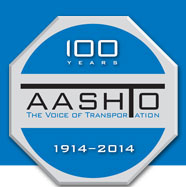
June 18, 2014
AASHTO Presidential Profile: George T. McCoy, Georgia

Nearly 40 years after the association was founded, AASHO selected George T. McCoy – described in American Highways magazine as the "Real McCoy" – as its 42nd president. McCoy, the state highway engineer of California, was elected president at the annual meeting in Seattle, Washington, in November 1954. He took over that leadership role at an eventful and important time for the association, when Alfred E. Johnson would start his longtime tenure as AASHO's third executive secretary and state highway officials were among those working hardest to help bring into existence the Interstate System.
McCoy was born on a stock ranch in Milton, Oregon, on Sept. 12, 1889. Along with helping to herd cattle and horses on that ranch during his youth, McCoy also found time to pursue his studies in nearby Walla Walla, Washington – first at the secondary-school level at Pearson's Academy and then at Whitman College.
While pursuing a liberal arts education and initially aspiring to become an attorney, McCoy ultimately found himself drawn to an engineering career. His summertime work during his college years, for example, included engineering work for the U.S. General Land Office and the Washington State Highway Department. Consequently, after graduating from Whitman College summa cum laude with a Bachelor of Arts degree in 1913, McCoy made his way out east to study engineering at Columbia University in New York City. After earning his degree there in 1915, McCoy eventually returned to the Northwest and began work at the Washington State Highway Department.
McCoy worked on a variety of engineering projects throughout the state. He left that agency after a couple of years to work as a bridge engineer in North Dakota and then on road projects in Montana and Idaho for the U.S. Bureau of Public Roads. McCoy then returned to the Washington State Highway Department, where he worked in the headquarters office in Olympia and rose through the ranks to assistant state highway engineer.
In 1927, McCoy made his way to Sacramento and began working for the California Highway Department. He started out as an assistant office engineer and soon became administrative assistant to State Highway Engineer Charles H. Purcell. When Purcell became increasingly focused on the San Francisco-Oakland Bay Bridge project during the 1930s, McCoy took on more and more of the responsibilities for administering the rest of California's state highway program. McCoy was promoted to assistant state highway engineer in 1933. When Purcell was appointed by Governor Earl Warren in 1943 to serve as state director of public works, McCoy became state highway engineer.
California's major highway achievements during McCoy's tenure included the widespread development of multilane highways that encompassed a variety of full freeways and expressway. McCoy helped set a high standard for the state when it came to not only road-building but long-range planning efforts.
He also achieved an almost legendary status for being able to deal with a variety of people in high-profile, high-pressure situations. While meeting one time in Mexico City with one of that nation's senior transportation officials, McCoy quickly realized that there was a formidable language barrier between them; McCoy did not speak any Spanish, and that official did not know English. They tried at first to communicate fast and furiously via sign language before stumbling on the fact that they both knew how to speak classical Greek. The remainder of their conference was spent talking to each other in that language.
Even as he made a notable impact both within California and even south of the border, McCoy also found time to immerse himself in AASHO's activities. "For the past few years Mr. McCoy's major interest apart from – and yet related to – his job of administering the vast California highway program has been the American Association of State Highway Officials," reported American Highways magazine at the time he was elected president. "He is devoted to the ideals of AASHO and convinced of its importance of a medium through which the nation's highway transportation system can best attain the standards of adequacy necessary to serve its growing economy."
McCoy's work on behalf of AASHO included serving as chairman of the Committee on Finance and first vice-president. His time as president would be largely defined by the unsuccessful efforts to push through Congress a bill authorizing the Interstate System. That legislative setback weighed heavily on him when he gave a less-than-positive assessment of his time leading the association.
"In the annals of American transportation, the year 1955 will probably prove to have seen more constructive talk and less constructive action than any comparable period in our modern highway history," he said in his remarks at the AASHO Annual Meeting in New Orleans in December 1955. "The past year has been momentous from the standpoint of proposals, public interest, research, information, hearings and programs. From the standpoint of immediate results, however, there is very little of a positive nature to report."
Nonetheless, those stalled legislative efforts would help lay the groundwork for a more successful initiative the following year that would result in the enactment of the Federal-Aid Highway Act of 1956 that made the Interstate System a reality. McCoy's tenure as president also witnessed the early stages for launching the AASHO Road Test, including the opening of a field office in Ottawa, Illinois, for what became those landmark scientific studies of the performance of highway pavements.
McCoy received many awards for his public service, including the Thomas H. MacDonald Award that was presented to him by AASHO in 1958. McCoy would remain California's state highway engineer until retiring in 1959 due to age requirements. He died in Monterey, California, on Dec. 24, 1965, at the age of 76.












